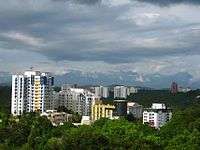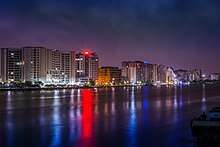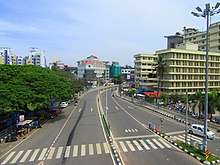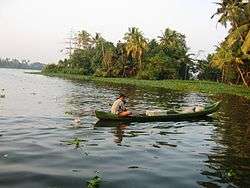Demographics of Kerala
| Location of Kerala in India | |
 | |
Kerala is a state in south-western India. Most of Kerala's 33.3 million people (in 2011) are of Malayali (Malayalam language speaking) ethnicity. Most of the Malayalam and English speaking Keralites derive their ancestry from Dravidian and Aryan communities that settled in Kerala and intermixed with each other and existing populations.[1] Additional ancestries derive from several centuries of contact with non-Indian lands, whereby people of Arab, Jewish, and other ethnicities settled in Kerala. Many of these immigrants intermarried with native Malayalam speakers.[2][3] A tiny number of Muslims thus take lineage from Arab settlers mixed with local population.
Malayalam is Kerala's official language and is spoken by at least 96% of the people of Kerala; the next most common languages are Hindi and Tamil, spoken mainly by migrant workers from North and eastern parts of India and also from the neighbouring state of Tamil Nadu. Tulu and Kannada is spoken in most parts of the northern district of Kasaragod, adjoining Karnataka. In addition, Kerala is home to 321,000 indigenous tribal Adivasis (1.10% of the populace).[4] Some 63% of tribals reside in the eastern districts of Wayanad (where 35.82% are tribals), Palakkad (1.02%), and Idukki (15.66%).[5] These groups, including the Irulars, Kurumbars, and Mudugars,[6] speak their own native languages.[7][8][9] Cholanaikkan tribe in the Silent Valley National Park were contacted only in the 1970s and they are the most isolated tribe in the state.
Population
| Population density of Kerala | |
| Source: (GOK 2001). | |
Kerala is home to 2.76% of India's people, and — at 859 persons per km²;[10] its land is three times as densely settled as the rest of India. However, Kerala's population growth rate is far lower than the national average. Whereas Kerala's population more than doubled between 1951 and 1991 — adding 15.6 million people to reach a total of 29.1 million residents in 1991 — the population stood at 31.8 million by 2001 and 33.3 million in 2011.[10] Kerala's people are most densely settled in the coastal region, leaving the eastern hills and mountains comparatively sparsely populated.[11]
Hinduism is followed by the majority of Keralites (54.7%).Kerala is home to Hindu saints and swamis of all castes. Jagatguru Sree Adi Shankaracharya, Sree Narayana Guru, Sree Chattambi Swamikal and Vaikunda Swami were the first among the saints of Kerala. The major religions followed in Kerala are Hinduism (54.7% — Hinduism of Kerala), Islam (26.6%) and Christianity (18.4%).[12] Kerala also had a tiny Jewish population until recently, said to date from 587 BC when they fled the occupation of Jerusalem by Nebuchadnezzar.[13] The 2001 Indian census recorded only 51 Jews in Kerala. The synagogue in Kochi is the oldest in the Commonwealth of Nations. The state has many famous Temples, Mosques, and Churches. The oldest church in India is found in Kerala, believed to be established by St. Thomas the disciple of Jesus Christ.
Features
Social development
Kerala ranks highest in India with respect to social development indices such as elimination of poverty, primary education and healthcare. This resulted from significant efforts begun in 1911 by the erstwhile Princely states of Cochin and Travancore to boost healthcare and education among the people and aided by the Christian missionaries. This central focus — unusual in India — was then maintained after Kerala's post-independence inauguration as a state.[14] Thus, Kerala has the highest literacy rate in India of 93.91% (2011);[15] and life expectancy is now the highest in India.The suicide rates in Kerala are the highest in India,[16] . As per the 2011 census, Kerala and Puducherry are the only states in India with a female-to-male ratio higher than 0.99. The ratio for Kerala is 1.084 — 1084 females per 1000 males — while the national figure is 0.940.[17] .It is also one of the state in India to have sub-replacement fertility. [18] UNICEF and the World Health Organization (WHO) designated Kerala the world's first "baby-friendly state" via its "Baby Friendly Hospital Initiative". The state is also known for Ayurveda, a traditional system of medicine — this traditional expertise is currently drawing increasing numbers of medical tourists. However, drawbacks to this situation includes the population's steady aging — indeed, 11.2% of Keralites are age 60 or over.[14]
Kerala's unusual socioeconomic and demographic situation was summarized by author and environmentalist Bill McKibben:[19]
Kerala, a state in India, is a bizarre anomaly among developing nations, a place that offers real hope for the future of the Third World. Though not much larger than Maryland, Kerala has a population as big as California's and a per capita annual income of around $2250. Its infant mortality rate is very low, its literacy rate among the highest on Earth, and its birthrate below America's and falling faster. Kerala's residents live nearly as long as Americans or Europeans. Though mostly a land of paddy-covered plains, statistically Kerala stands out in social development; there's truly no place like it.
Emigration
As of 2011, a total of 2,280,000 Keralites reside outside India. Largest populations are found in UAE (883,313) and USA (680,076).[20]
As of 2011, the major concentrations of expat Keralites are in the following nations:[21]
- UAE - 883,313
- United States - 680,076 (mainly U.S. Citizens)
- KSA - 574,739
- Oman - 195,300
- Qatar - 410,000
- Kuwait - 127,782
- Bahrain - 216,000
- United Kingdom - 44,640
Diversity
There are more than 2,500,000 migrants living in Kerala,[22] mostly from Assam and West Bengal, constituting more than 8% of the population. There are also migrants from Bihar, Jharkhand, Chhattisgarh, Orissa, and the North East.[23] In some places like Perumbavoor they outnumber the locals.[24] Some alarmists have even written that "of late, Kerala has been hearing more Bengali than its own local language",[25] which is a huge exaggeration, since there are very few migrants in Northern and Southern Kerala. Most of the migrants tend to concentrate around central Kerala, especially in Kochi (Notable exceptions would be Thiruvananthapuram and Kozhikode. In Kozhikode, northern immigrants constitute more than 8% of the total population, at 35,000).[22]
Studies indicate that by the time of 2016 state elections, migrants will become a crucial voting block in many of the constituencies in Thiruvananthapuram, Kochi, Kozhikode, Thrissur and Kannur.[26]
Lists
Most populous urban agglomerations
The following is a list of most populous urban agglomerations in the Kerala state of India. Population statistics indicated in this article as of 2011 census.[27][28][29][30] Note that this is a list of metropolitan population and does not indicate the city populations. For that, see List of most populous cities in India.
| Rank | UA | Population (2011) | Population (2001) | District |
|---|---|---|---|---|
| 1 | Kochi | 2,117,990 | 1,355,972 | Ernakulam |
| 2 | Kozhikode | 2,030,519 | 1,015,681 | Kozhikode |
| 3 | Thrissur | 1,854,783 | 1030,122 | Thrissur |
| 4 | Malappuram | 1,698,645 | 170,409 | Malappuram |
| 5 | Thiruvananthapuram | 1,679,754 | 889,635 | Thiruvananthapuram |
| 6 | Kannur | 1,642,892 | 498,207 | Kannur |
| 7 | Kollam | 1,110,005 | 380,091 | Kollam |
| 8 | Cherthala | 455,408 | 141,558 | Alappuzha |
| 9 | Kayamkulam | 427,091 | 68,585 | Alappuzha |
| 10 | Kottayam | 357,533 | 172,878 | Kottayam |
| 11 | Palakkad | 293,566 | 283,369 | Palakkad |
| 12 | Alappuzha | 241,072 | 282,675 | Alappuzha |
| 13 | Ottappalam | 238,238 | 49,242 | Palakkad |
| 14 | Kanhangad | 229,706 | 129,367 | Kasaragod |
| 15 | Kasaragod | 192,761 | 75,968 | Kasaragod |
| 16 | Changanassery | 127,971 | 51,967 | Kottayam |
| 17 | Chalakkudy | 114,901 | 48,380 | Thrissur |
| 18 | Kothamangalam | 114,574 | 37,173 | Ernakulam |
Class I cities
Kerala has seven million-plus cities: Kochi, Kozhikode, Thrissur, Malappuram, Thiruvananthapuram, Kannur and Kollam. Over a third of Keralites live in these large cities (a higher percentage than any other state), and over half the population lives in urban centres.[31]
| No. | City | District | Population | Images |
|---|---|---|---|---|
| 1 | Thiruvananthapuram | Thiruvananthapuram | 752,490 |  |
| 2 | Kochi | Ernakulam | 601,574 |  |
| 3 | Kozhikode | Kozhikode | 432,097 |  |
| 4 | Kollam | Kollam | 349,033 |  |
| 5 | Thrissur | Thrissur | 315,596 |  |
| 6 | Alappuzha | Alappuzha | 174,164 |  |
| 7 | Palakkad | Palakkad | 131019 | |
| Source: 2011 Census of India[32] | ||||
According to World Gazetteer[33] population calculation for the year 2010, five of the top 100 most populous metropolitan areas in India belong to Kerala. They are Kochi, Thiruvananthapuram, Kozhikode, Kannur and Kollam ranking 26, 43, 46, 73 and 86 respectively.
Ethnic groups
The great majority of residents of Kerala are Malayalis, but there are many smaller ethnic groups including Tuluvas, Tamils, Kannadigas and Konkanis. In addition, as of early 2013 there are close to 2.5 million (7.5% of state population) migrant workers from other states of India in Kerala.[34]
Religion/caste communities
| Castes of Kerala[35][36][37][38][39] | ||
|---|---|---|
| Caste | Population (%) | |
| Ezhavas (Religion:Hindu) | 20.90% | |
| Nairs (Religion:Hindu) | 12.10% | |
| Dheevars (Religion:Hindu) | 3% | |
| SCs (Dalits) (Religion:Hindu) | 9.8% | |
| Adivasis(STs) (Religion:Hindu) | 1.14% | |
| Brahmins (Religion:Hindu) | 1% | |
| Namboodiri Brahmins (Religion:Hindu) | 1% | |
| Muslims | 27% | |
| Christians | 18.5% | |
| Other Backward Castes (Religion:Hindu) | 3% | |
| Others (Religion: Hindu Vaishyas (Vanian, Vanika, Vanika Vaisya), Hindu intermediate castes, Kudumbi - Hindu, Kusavan - Hindu, Viswakarmas - Hindu, Atheist, Jews, Buddhist, Animists, Sikhs, Parsis) | 2.56% | |
The Scheduled Caste (SC) population of Kerala State is 3,123,941 which is 9.8% of overall population. Scheduled Tribes in Kerala with a population of 3.64 lakh constitute 1.14% of the population of state. Denominations groups among Christians [40]
Catholic church (Syrian and Latin rites) is the largest denomination among Kerala Christians. Malankara orthodox church, Jacobite Syrian orthodox church and Marthomite Syrian church denominations claim Syrian roots. Major Protestant groups are: Church of South India(C.S.I.) and various Pentecostal churches are major Protestant churches.Chaldean, Seventh Day Adventists, Salvation army etc. are some of the other denominations. Denominations should not be considered as caste or ethnic groups. Caste groups among Christians, which is a continuation of casteism in Hinduism, runs parallel to denominational divisions. One caste group may be spread over many denominations. One denomination may have more than one caste group in it. Person belonging to a denomination can convert to another denomination. Hence definitely these are not ethnic divisions.[41]
- Muslims - 26.6% (2011 census).
Calden Syrian (paavu m pillerum)=12% Mayukh= only one
Age structure
- 0-6 years: 3322247 or 9.95% (male 1695935/1626312 female )(2011 census)
- 7-14 years: 23.9%
- 15-59 years: 54.3%
- 60 years and over:12.8%
Median age
- Year :1961 1971 1981 1991 2001
- Total:19.28 19.39 21.81 24.36 28.87...
- Male:
- Female:
Population growth rate
- 4.91% (2001-2011)[42]
Birth rate
| Religion | 2016[44] | % | 2015[45] | % | 2014[46] | % | 2013[47] | % | 2012[48] | % | 2011[49] | % | 2010[50] | % | 2009[51] | % | 2008[52] | % | 2007[53] | % |
|---|---|---|---|---|---|---|---|---|---|---|---|---|---|---|---|---|---|---|---|---|
| Hindu | 207,831 | 41.88% | 221,220 | 42.87% | 231,031 | 43.23% | 236,420 | 44.08% | 214,591 | 38.99% | 248,610 | 44.37% | 246,297 | 45.03% | 247,707 | 45.51% | 241,305 | 45.04% | 250,094 | 45.88% |
| Muslim | 211,182 | 42.55% | 213,865 | 41.45% | 218,437 | 40.87% | 214,257 | 39.96% | 175,892 | 31.96% | 214,099 | 38.21% | 209,276 | 38.26% | 204,711 | 37.61% | 194,583 | 36.32% | 183,796 | 33.71% |
| Christian | 76,205 | 15.35% | 79,565 | 15.42% | 83,616 | 15.65% | 84,660 | 15.78% | 102,546 | 18.63% | 94,664 | 16.90% | 88,936 | 16.26% | 90,451 | 16.62% | 94,175 | 17.58% | 98,220 | 18.02% |
| Others | 852 | 0.18% | 933 | 0.18% | 1,178 | 0.22% | 869 | 0.16% | 57,215 | 10.39% | 2,671 | 0.48% | 651 | 0.12% | 704 | 0.13% | 5,151 | 0.96% | 6,108 | 1.12% |
| Not Stated | 222 | 0.04% | 430 | 0.08% | 196 | 0.03% | 146 | 0.02% | 167 | 0.03% | 224 | 0.04% | 1,806 | 0.33% | 775 | 0.14% | 524 | 0.10% | 6,936 | 1.27% |
| Total | 496,292 | 100% | 516,013 | 100% | 534,458 | 100% | 536,352 | 100% | 550,411 | 100% | 560,268 | 100% | 546,964 | 100% | 544,348 | 100% | 535,738 | 100% | 545,154 | 100% |
54.73% of Kerala's residents are Hindus who contribute 42.87% of the total child births, 26.56% are Muslims who contribute to 41.45% of total child births, 18.38% are Christians who contribute 15.42% of the total child births, and the remaining 0.32% others contribute 0.26% of the total child births.
- In 2007, 45.88% of all live births were Hindus, 33.71% Muslims and 18.02% Christians.[54]
- In 2008, 45.04% of all live births were Hindus, 36.32% Muslims and 17.58% Christians.[55]
- In 2010, 45.03% of all live births were Hindus, 38.26% Muslims and 16.26% Christians.[56]
- In 2011, 44.37% of all live births were Hindus, 38.21% Muslims and 16.90% Christians.[57]
Birth Rate was 17.1 in 1994-2001 (20.3 in 1984-1990 & 25.0 in 1974-1980) . Pathanamthitta (14.5 in 1994-2001, 17.2 in 1984-1990 & NA in 1974-1980) had the lowest TBR and Malappuram(22.4, 29.5 & 33.6) had the highest TBR.
According to the 2011 Census, the Thiruvalla taluk is having the lowest birth rate and the Tirurangadi taluk is having the highest birth rate.[58]
Lowest Birth Rate (2011):
- Thiruvalla - 10.63 per 1,000
- Mallappally - 10.69 per 1,000
- Kozhenchery - 10.86 per 1,000
- Chengannur - 10.93 per 1,000
- Adoor - 11.09 per 1,000
Highest Birth Rate (2011):
- Tirurangadi - 19.99 per 1,000
- Ernad - 19.68 per 1,000
- Perinthalmanna - 19.43 per 1,000
- Tirur - 19.16 per 1,000
- Nilambur - 18.34 per 1,000
Vital stats for the year 2011:[57]
| Community | Pop | Births | Birth Rate | Deaths | Death Rate | NGR% |
|---|---|---|---|---|---|---|
| Total | 33,406,061 | 560,268 | 16.77 | 245,002 | 7.33 | 0.94% |
| Hindu | 18,282,492 | 248,610 | 13.60 | 148,097 | 8.10 | 0.55% |
| Muslim | 8,873,472 | 214,099 | 24.13 | 45,305 | 5.11 | 1.90% |
| Christian | 6,141,269 | 94,664 | 15.41 | 50,365 | 8.20 | 0.72% |
Death rate
- 7.0 deaths/1,000 population (2006-10)[59]
- In 2007, 61.55% of the deaths were reported from Hindus, 17.50% from Muslims and, 19.75% from Christians.[54]
- In 2008, 61.01% of the deaths were reported from Hindus, 17.82% from Muslims and, 20.06% from Christians.[55]
- In 2010, 60.79% of the deaths were reported from Hindus, 18.31% from Muslims and, 20.36% from Christians.[56]
- In 2011, 60.45% of the deaths were reported from Hindus, 18.48% from Muslims and, 20.56% from Christians.[57]
Net migration rate
- (-)3.1 migrant(s)/1,000 population (1991 est.)
Of the emigrants from Kerala, 42.2% were Muslims, 36.6% were Hindus and 21.2% were Christians in 1992-93. The most preferred destination was USA (37.8%), followed by UAE (25.9%), Other Gulf countries (13.0%), Oman (11.8%), Other Countries (7.5%) and Saudi Arabia(3.8%).
Sex ratio
According to the 2011 census, women outnumber men in all the districts of Kerala with the highest proportion in Kannur and Pathanamthitta districts.
| Districts | Population | Males | % | Females | % |
|---|---|---|---|---|---|
| Thiruvananthapuram | 3,301,427 | 1,581,678 | 47.9% | 1,719,749 | 52.1% |
| Kollam | 2,635,375 | 1,246,968 | 47.3% | 1,388,407 | 52.7% |
| Pathanamthitta | 1,197,412 | 561,716 | 46.8% | 635,696 | 53.2% |
| Alappuzha | 2,127,789 | 1,013,142 | 47.6% | 1,114,647 | 52.4% |
| Kottayam | 1,974,551 | 968,289 | 49% | 1,006,262 | 51% |
| Idukki | 1,108,974 | 552,808 | 49.8% | 556,166 | 50.2% |
| Ernakulam | 3,282,388 | 1,619,557 | 49.3% | 1,662,831 | 50.7% |
| Thrissur | 3,121,200 | 1,480,763 | 47.4% | 1,640,437 | 52.6% |
| Palakkad | 2,809,934 | 1,359,478 | 48.4% | 1,450,456 | 51.6% |
| Malappuram | 4,112,920 | 1,960,328 | 47.7% | 2,152,592 | 52.3% |
| Kozhikode | 3,086,293 | 1,470,942 | 47.7% | 1,615,351 | 52.3% |
| Waynad | 817,420 | 401,684 | 49.1% | 415,736 | 50.9% |
| Kannur | 2,523,003 | 1,181,446 | 46.8% | 1,341,557 | 53.2% |
| Kasargod | 1,307,375 | 628,613 | 48.1% | 678,762 | 51.9% |
Infant mortality rate
- Total: 11 deaths/1,000 live births (2011-2012)
Maternal mortality rate
- Total: 1.3 deaths/1,000 live births (1990)
Life expectancy at birth
- 81 years
Total fertility rate
- 1.70 children born/woman (2001 Cen)
In 1991, Kerala had the lowest TFR (Children born per women) in the whole of India. Hindus had a TFR of 1.66, Christians had 1.78 and Muslims had 2.97. In 2000, the TFR was 1.73 with Muslims having 2.28, Nairs having a TFR of 1.47 and Syrian Christians having TFR of 1.55. TFR for Scheduled Castes was 1.52 in 1997-98 and 1.37 in 1992-93. The lowest Fertility rate recorded anywhere in India is TFR of 1.17 for Vettuvan caste in Kerala.
See also
References
- ↑ Social and cultural history of Kerala by A. Sreedhara Menon p47,p61. Books.google.co.in. Retrieved 20 November 2014.
- ↑ Western Influence on Malayalam Language and Literature by K. M. George, p2, ISBN 81-260-0413-4 Google book
- ↑ Caste, Class and Catholicism in India 1789-1914 by Kenneth Ballhatchet, p2, ISBN 0-7007-1095-7
- ↑ (Kalathil 2004, p. 10).
- ↑ (Kalathil 2004, p. 12).
- ↑ (Kalathil 2004, pp. 13–14).
- ↑ (Kalathil 2004, pp. 30–32).
- ↑ (Kalathil 2004, p. 37).
- ↑ (Kalathil 2004, p. 39).
- 1 2 "Census of India : Provisional Population Totals India : Paper1 : Census 2011". Censusindia.gov.in. Retrieved 2014-08-16.
- ↑ (GOK 2005b).
- ↑ "Indian Census". Censusindia.gov.in. Retrieved 20 November 2014.
- ↑ Edna Fernandes, The Last Jews of Kerala, Skyhorse Publishing, 2008
- 1 2 (Varma 2005).
- ↑ Archived September 3, 2013, at the Wayback Machine.
- ↑ http://ncrb.nic.in/StatPublications/ADSI/ADSI2015/chapter-2%2520suicides-v1.pdf&ved=0ahUKEwibmOS41p_XAhUBLo8KHVjhCeUQFgh7MAk&usg=AOvVaw1qQ89yX7CZ0QKT6J9VigMn
- ↑ http://www.censusindia.gov.in/2011-Common/CensusData2011.html
- ↑ http://niti.gov.in/content/total-fertility-rate-tfr-birth-woman.
- ↑ (McKibben 2006).
- ↑ "Migration From Kerala Growing Steadily, Shows Study". Daijiworld.com. Retrieved 2014-08-16.
- ↑ "A Gulf without Keralites could soon be a reality". Emirates 24/7. 2012-10-18. Retrieved 2014-08-16.
- 1 2 Archived January 31, 2011, at the Wayback Machine.
- ↑ "In Migrants' Own Country". Indian Express. 2011-07-24. Retrieved 2014-08-16.
- ↑ "No Malayalam please, we're Bongs". The Telegraph. Kolkata, India. 10 August 2008.
- ↑
- ↑ Rakesh, K.M. (20 April 2011). "Missing voters". The Telegraph. Kolkata, India.
- ↑ "ALPHABETICAL LIST OF TOWNS AND THEIR POPULATION" (PDF).
- ↑ "Population Analysis with list of UAs and their Population" (PDF).
- ↑ http://www.censusindia.gov.in/2011-prov-results/paper2-vol2/data_files/kerala/Analysis_Census_Data.pdf
- ↑ "Analysis of Census Date : 2011" (PDF). Censusindia.gov.in. Retrieved 2015-05-20.
- ↑ "One in 3 Keralites lives in big cities". The Times Of India. 28 October 2011.
- ↑ "Provisional Population Totals, Census of India 2011" (PDF). Cities with population greater than or equal to one lakh by size class in the state, 2011. Government of India. Retrieved 29 October 2016.
- ↑ "India: metropolitan areas". World Gazetteer. Archived from the original on December 21, 2008. Retrieved 17 February 2010.
- ↑ PTI (2013-02-16). "Migrant worker population in Kerala touches 2.5 m | Business Line". Thehindubusinessline.com. Retrieved 2014-08-16.
- ↑ "Guess who's after the Hindu vote in Kerala? (Hint: It's not the BJP)".
- ↑ "Caste-based organisations NSS, SNDP form Hindu Grand Alliance in Kerala".
- ↑ "The communal polarisation of Kerala's voters".
- ↑ http://www.thehindu.com/todays-paper/tp-national/tp-kerala/dheevara-sabha-calls-for-redefining-minority-status/article3101517.ece
- ↑ "Brahmins in India".
- ↑ http://censusindia.gov.in/Tables_Published/SCST/dh_sc_kerala.pdf
- ↑ "The Hindu : Kerala News : Increase in Muslim population in the State". Thehindu.com. Retrieved 20 November 2014.
- ↑ "Kerala Census: Child population declines". The Hindu. 6 Jan 2014.
- ↑ "Vital Statistics Reports,". Government of Kerala, Vital Statistics Division Department of Economics & Statistics Thiruvananthapuram. Retrieved 2016-06-01.
- ↑ http://www.ecostat.kerala.gov.in/images/pdf/publications/Vital_Statistics/data/vital_statistics_2016.pdf
- ↑ "Annual Vital Statistics Report – 2015, Page Number 21" (PDF). Government of Kerala, Vital Statistics Division Department of Economics & Statistics Thiruvananthapuram. Retrieved 2017-05-24.
- ↑ "Annual Vital Statistics Report – 2014, Page Number 22" (PDF). Government of Kerala, Vital Statistics Division Department of Economics & Statistics Thiruvananthapuram. Retrieved 2016-06-01.
- ↑ "Annual Vital Statistics Report – 2013, Page Number 22" (PDF). Government of Kerala, Vital Statistics Division Department of Economics & Statistics Thiruvananthapuram. Retrieved 2015-07-01.
- ↑ "Annual Vital Statistics Report – 2012, Table – 2.7 (a), Page Number 23" (PDF). Government of Kerala, Vital Statistics Division Department of Economics & Statistics Thiruvananthapuram. Retrieved 2014-11-01.
- ↑ "Annual Vital Statistics Report – 2011, Table – 2.7 (a), Page Number 23" (PDF). Government of Kerala, Vital Statistics Division Department of Economics & Statistics Thiruvananthapuram. Retrieved 2014-02-01.
- ↑ "Annual Vital Statistics Report – 2010, Table – 2.7 (a), Page Number 23-24" (PDF). Government of Kerala, Vital Statistics Division Department of Economics & Statistics Thiruvananthapuram. Retrieved 2013-03-01.
- ↑ "Annual Vital Statistics Report – 2009, Table – 2.7 (a), Page Number 19-20" (PDF). Government of Kerala, Vital Statistics Division Department of Economics & Statistics Thiruvananthapuram. Retrieved 2011-10-01.
- ↑ "Annual Vital Statistics Report – 2008, Table – 1.7 (a), Page Number 19-20" (PDF). Government of Kerala, Vital Statistics Division Department of Economics & Statistics Thiruvananthapuram. Retrieved 2010-03-01.
- ↑ "Annual Vital Statistics Report – 2007, Table – 1.7 (a), Page Number 16" (PDF). Government of Kerala, Vital Statistics Division Department of Economics & Statistics Thiruvananthapuram. Retrieved 2009-06-01.
- 1 2 "Annual Vital Statistics Report 2007" (PDF). Ecostat.kerala.gov.in. Retrieved 2015-05-20.
- 1 2 "Annual Vital Statistics Report 2008" (PDF). Ecostat.kerala.gov.in. Retrieved 2015-05-20.
- 1 2 "Annual Vital Statistics Report 2010" (PDF). Ecostat.kerala.gov.in. Retrieved 2015-05-20.
- 1 2 3 "Annual Vital Statistics Report 2011" (PDF). Ecostat.kerala.gov.in. Retrieved 2015-05-20.
- ↑
- ↑ "Death statistics â€" Crude death rate in India". Indiastat.com. Retrieved 2014-08-16.